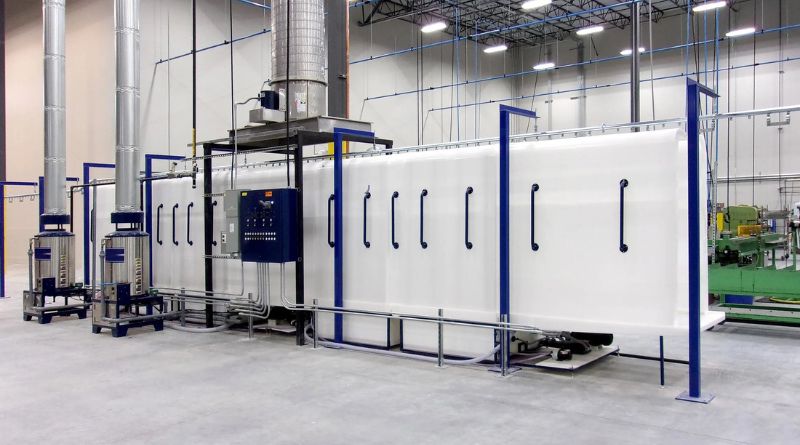For companies focused on large batch production, using the right powder coating machine is especially important. While some machines may be suitable for smaller jobs, others may struggle to keep up with high-volume demands. Understanding the limitations of these machines helps businesses make informed decisions about their production processes.
Limited Throughput Capacities Impact High-Volume Production
When it comes to powder coating, throughput—the amount of product processed in a given time frame—plays a major role in determining the right equipment. Not all powder coating machines are built to handle the sheer volume required for large batch production. Machines designed for smaller runs may work well for individual projects but struggle with maintaining a steady pace during high-volume operations.
In larger production environments, efficiency is everything. The machine’s throughput capacity directly impacts production timelines and costs. If a machine isn’t able to keep up with the high-demand pace of bulk orders, workers may experience delays, and the operation’s overall speed could take a hit. This gap in throughput capacity means that smaller, less robust machines often require more downtime, reducing their ability to support larger-scale operations effectively.
Inconsistent Temperature Control Challenges Large Batch Consistency
One of the key factors in achieving uniform results with powder coating is temperature control. In large batches, achieving consistency across all items is essential. However, not all powder coating machines are equipped with the precise temperature regulation needed to keep the coating process stable across a large quantity of items.
Temperature fluctuations can lead to uneven coatings, with some areas overcooked and others undercooked. This inconsistency is especially problematic for bulk operations, where consistency is a hallmark of quality. Powder coating ovens with subpar temperature control may find it difficult to handle multiple items at once, leading to waste and increased production costs. For large-scale production, a reliable machine with precise temperature regulation is non-negotiable.
Powder Delivery Systems Struggle with Bulk Coverage Demands
Delivering the right amount of powder evenly across all surfaces of an item is another challenge in large batch production. While a standard powder coating machine may work fine for smaller projects, it could fall short when tasked with coating larger quantities. The powder delivery system often struggles to cover items efficiently in bulk, resulting in uneven application or wasted material.
A machine’s ability to handle bulk coverage is determined by its delivery system’s design and output capacity. In large production runs, any imbalance in powder delivery can cause imperfections in the final product or slow down the entire operation. A powder coating machine designed for large batches must have a superior powder delivery system that can handle high-volume demands without compromising the quality of the finish.
Cycle Time Constraints Reduce Efficiency in High-Volume Settings
Cycle time—the amount of time it takes to complete the coating process—directly impacts how efficiently a production line runs. Some powder coating machines have long cycle times, which can slow down the entire operation in large batch environments. Machines that are not optimized for high-volume production can create bottlenecks, leading to delays and slower overall throughput.
In high-volume settings, minimizing cycle time is critical. The faster a machine can process batches, the higher the production capacity. Machines that struggle with long cycle times often force operators to spend more time loading, unloading, and monitoring the system, reducing their ability to focus on other important tasks. This inefficiency becomes a significant barrier when scaling up production to meet large order requirements.
Inadequate Ventilation Systems Hinder Large Batch Efficiency
Efficient ventilation is a key component in any powder coating operation. Adequate airflow helps to control temperature and maintain consistent coating quality, especially during extended production runs. However, not all powder coating machines come with ventilation systems capable of handling the demands of high-volume production.
Inadequate ventilation can cause overheating, disrupt the curing process, or even lead to unsafe working conditions. In large batch environments, poor ventilation creates additional risks that could compromise worker safety and product quality. Machines equipped with proper ventilation ensure smooth, efficient operations that can handle the high output of bulk production without sacrificing quality.
Size and Configuration Limitations Affect Bulk Item Handling
Handling larger items in bulk requires a machine that can be configured to accommodate various sizes and shapes. Many powder coating machines, especially those not designed for high-volume production, may have limitations in their size and configuration options. This becomes especially evident when trying to coat large or irregularly shaped items, which are often a part of large batch production.
Machines that are too small or rigidly configured can make it difficult to position items efficiently, leading to longer setup times and higher labor costs. A well-designed powder coating machine for large batches will offer flexibility in terms of size and configuration, making it easier to manage a variety of items while maintaining production efficiency.
Component Durability Issues Under Extended Operational Stress
Any machine subjected to continuous, high-demand use faces the risk of wear and tear. In large batch production, the extended operational stress on the components of a powder coating machine can lead to durability issues. Machines not built to withstand the heavy demands of high-volume use may experience faster degradation, resulting in costly repairs or equipment failure.
Inconsistent performance due to worn-out parts can slow down production or even halt it completely, which is a significant issue in a fast-paced manufacturing environment. A durable, heavy-duty machine built to handle large batch production ensures consistent results and minimizes downtime, keeping the operation running smoothly and efficiently.
